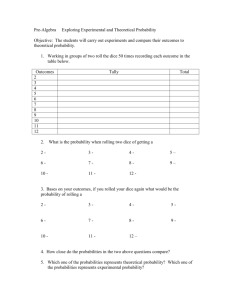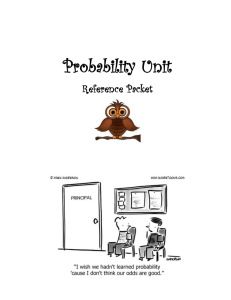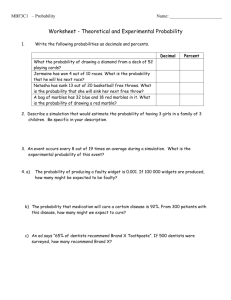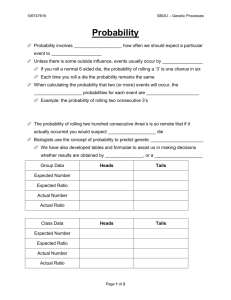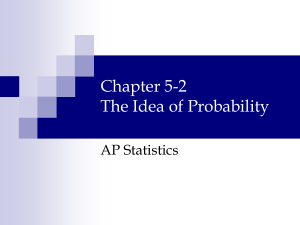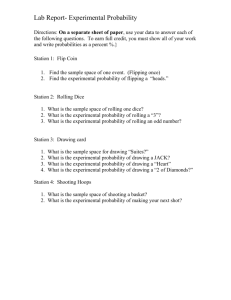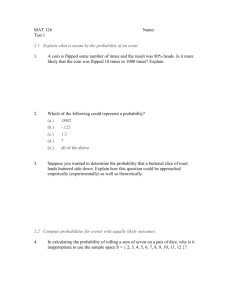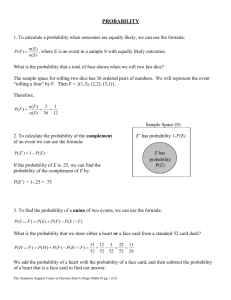An Introduction to Probability
advertisement
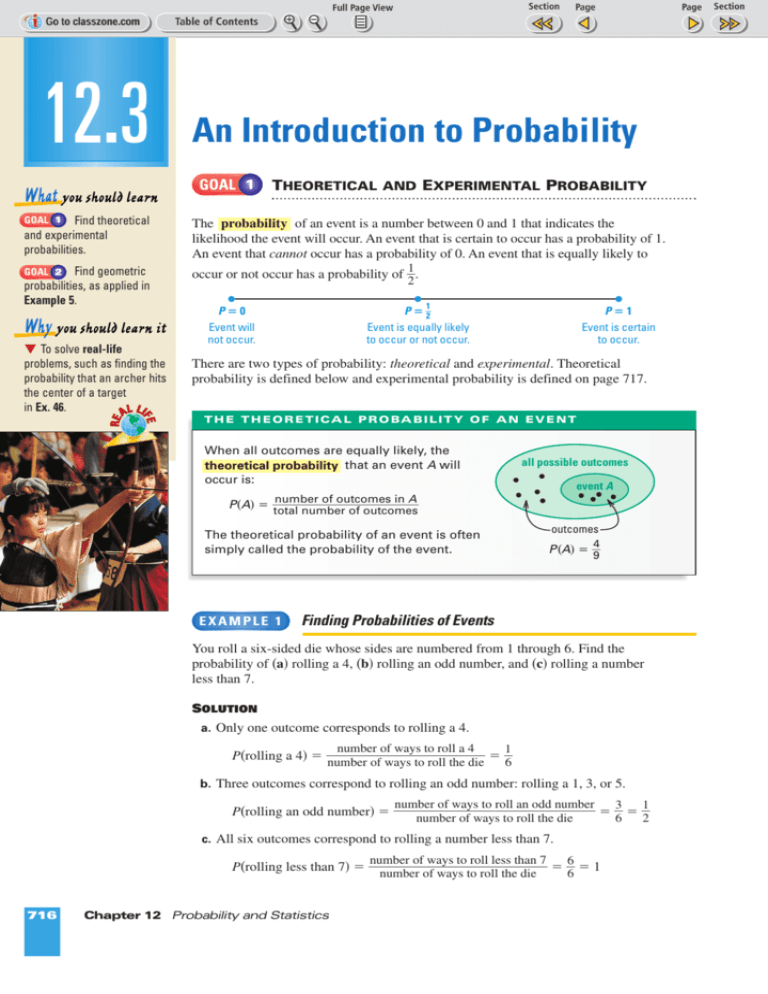
Page 1 of 2 12.3 What you should learn An Introduction to Probability GOAL 1 THEORETICAL AND EXPERIMENTAL PROBABILITY GOAL 1 Find theoretical and experimental probabilities. The probability of an event is a number between 0 and 1 that indicates the likelihood the event will occur. An event that is certain to occur has a probability of 1. An event that cannot occur has a probability of 0. An event that is equally likely to GOAL 2 Find geometric probabilities, as applied in Example 5. occur or not occur has a probability of . Why you should learn it RE FE To solve real-life problems, such as finding the probability that an archer hits the center of a target in Ex. 46. AL LI 1 2 1 P0 Event will not occur. P2 Event is equally likely to occur or not occur. P1 Event is certain to occur. There are two types of probability: theoretical and experimental. Theoretical probability is defined below and experimental probability is defined on page 717. T H E T H E O R E T I C A L P R O BA B I L I T Y O F A N E V E N T When all outcomes are equally likely, the theoretical probability that an event A will occur is: all possible outcomes event A number of outcomes in A P(A) = total number of outcomes outcomes 4 P(A) = 9 The theoretical probability of an event is often simply called the probability of the event. EXAMPLE 1 Finding Probabilities of Events You roll a six-sided die whose sides are numbered from 1 through 6. Find the probability of (a) rolling a 4, (b) rolling an odd number, and (c) rolling a number less than 7. SOLUTION a. Only one outcome corresponds to rolling a 4. number of ways to roll a 4 number of ways to roll the die 1 6 P(rolling a 4) = = b. Three outcomes correspond to rolling an odd number: rolling a 1, 3, or 5. number of ways to roll an odd number number of ways to roll the die 3 6 1 2 P(rolling an odd number) = = = c. All six outcomes correspond to rolling a number less than 7. number of ways to roll less than 7 number of ways to roll the die 6 6 P(rolling less than 7) = = = 1 716 Chapter 12 Probability and Statistics Page 1 of 2 You can express a probability as a fraction, a decimal, or a percent. For instance, in part (b) of Example 1 the probability of rolling an odd number can be written as 1 , 0.5, or 50%. 2 RE FE L AL I Music EXAMPLE 2 Probabilities Involving Permutations or Combinations You put a CD that has 8 songs in your CD player. You set the player to play the songs at random. The player plays all 8 songs without repeating any song. a. What is the probability that the songs are played in the same order they are listed on the CD? b. You have 4 favorite songs on the CD. What is the probability that 2 of your favorite songs are played first, in any order? SOLUTION a. There are 8! different permutations of the 8 songs. Of these, only 1 is the order STUDENT HELP in which the songs are listed on the CD. So, the probability is: Skills Review For help with converting decimals, fractions, and percents, see p. 906. 1 8! 1 40,320 P(playing 8 in order) = = ≈ 0.0000248 b. There are 8C2 different combinations of 2 songs. Of these, 4C2 contain 2 of your favorite songs. So, the probability is: 4C 2 6 28 3 14 P(playing 2 favorites first) = = = ≈ 0.214 8C 2 .......... Sometimes it is not possible or convenient to find the theoretical probability of an event. In such cases you may be able to calculate an experimental probability by performing an experiment, conducting a survey, or looking at the history of the event. Internet EXAMPLE 3 Finding Experimental Probabilities In 1998 a survey asked Internet users for their ages. The results are shown in the bar graph. Find the experimental probability that a randomly selected Internet user is (a) at most 20 years old, and (b) at least 41 years old. Source: GVU’s WWW User Surveys™ SOLUTION The number of people surveyed was 1636 + 6617 + 3693 + 491 + 6 = 12,443. a. Of the people surveyed, 1636 are at most 20 years old. So, the probability is: Internet Users Age (years) RE FE L AL I Under 21 21–40 41–60 61–80 Over 80 1636 6617 3693 491 6 0 2000 4000 6000 Number of users 1636 12,443 P(user is at most 20) = ≈ 0.131 b. Of the people surveyed, 3693 + 491 + 6 = 4190 are at least 41 years old. So, the probability is: 4190 12,443 P(user is at least 41) = ≈ 0.337 12.3 An Introduction to Probability 717 Page 1 of 2 GOAL 2 GEOMETRIC PROBABILITY Some probabilities are found by calculating a ratio of two lengths, areas, or volumes. Such probabilities are called geometric probabilities. EXAMPLE 4 Using Area to Find Probability You throw a dart at the board shown. Your dart is equally likely to hit any point inside the square board. Are you more likely to get 10 points or 0 points? 3 in. SOLUTION 10 The two probabilities are as follows. STUDENT HELP Skills Review For help with area, see p. 914. 5 2 area of smallest circle P(10 points) = area of entire board 0 π • 32 9π π 324 36 18 area outside largest circle P(0 points) = area of entire board = = = ≈ 0.0873 2 182 º (π • 92) 18 324 º 81π 324 4ºπ 4 = = = ≈ 0.215 2 RE FE L AL I Entertainment You are more likely to get 0 points. EXAMPLE 5 Using Length to Find Probability You have recorded a 2 hour movie at the beginning of a videocassette that has 6 hours of recording time. Starting at a random location on the videocassette, your brother records a 30 minute television show. What is the probability that your brother’s television show accidentally records over part of your movie? SOLUTION INT STUDENT HELP NE ER T HOMEWORK HELP Visit our Web site www.mcdougallittell.com for extra examples. You can think of the videocassette as a number line from 0 to 6. The movie can be represented as a line segment 2 units long and the television show as a line segment 0.5 unit long. Because you know the movie starts at the beginning of the videocassette, the number line is as shown. movie 0 1 2 3 4 5 6 If the 30 minute, or half hour, television show is to fit on the tape, it must start somewhere between 0 and 5.5. If it records over part of the movie, it must start somewhere between 0 and 2. So, the probability of recording over part of the movie is: length where show will record over movie length where show will fit on tape P(recording over movie) = 2º0 5.5 º 0 2 5.5 4 11 = = = ≈ 0.364 718 Chapter 12 Probability and Statistics Page 1 of 2 GUIDED PRACTICE Vocabulary Check Concept Check ✓ ✓ 1. Complete this statement: A probability that involves length, area, or volume is ? probability. called a(n) 2. P(A) = 0.2 and P(B) = 0.6. Which event is more likely to occur? Explain. 3. Explain the difference between theoretical probability and experimental probability. Give an example of each. Skill Check ✓ A jar contains 2 red marbles, 3 blue marbles, and 1 green marble. Find the probability of randomly drawing the given type of marble. 4. a red marble 5. a green marble 6. a blue or a green marble 7. a red or a blue marble Find the probability that a dart thrown at the given target will hit the shaded region. Assume the dart is equally likely to hit any point inside the target. The targets and regions within are either squares, circles, or triangles. 9. 10. 3 3 32 6 POPULATION The bar graph shown gives the resident population (in thousands) of the United States in 1997. For a randomly selected person in the United States, find the probability of the given event. INT 11. NE ER T 6 United States Population Population (thousands) 8. 120,000 60,000 83,608 55,446 34,076 0 24 and 25 to 44 45 to 64 65 and under older Age (years) DATA UPDATE of Statistical Abstract of the United States data at www.mcdougallittell.com a. The person is 24 years old or under. 94,507 b. The person is at least 45 years old. PRACTICE AND APPLICATIONS STUDENT HELP Extra Practice to help you master skills is on p. 956. CHOOSING NUMBERS You have an equally likely chance of choosing any integer from 1 through 20. Find the probability of the given event. 12. An odd number is chosen. 13. A number less than 7 is chosen. 14. A perfect square is chosen. 15. A prime number is chosen. 16. A multiple of 3 is chosen. 17. A factor of 240 is chosen. CHOOSING CARDS A card is drawn randomly from a standard 52-card deck. Find the probability of drawing the given card. STUDENT HELP Look Back For help with a standard 52-card deck, see p. 708. 18. the ace of hearts 19. any ace 20. a diamond 21. a red card 22. a card other than 10 23. a face card (a king, queen, or jack) 12.3 An Introduction to Probability 719 Page 1 of 2 ROLLING A DIE The results of rolling a six-sided die 120 times are shown. STUDENT HELP HOMEWORK HELP Use the table to find the experimental probability of each event. Also find the theoretical probability. How do the probabilities compare? Example 1: Exs. 12–23 Example 2: Exs. 35–40 Example 3: Exs. 24–29, 41–43 Example 4: Exs. 30–34, 46, 47 Example 5: Exs. 44, 45 Results from Rolling a Die 120 Times Roll Number of occurrences 1 2 3 4 5 6 15 18 20 17 24 26 24. rolling a 6 25. rolling a 3 or 4 26. rolling an odd number 27. rolling an even number 28. rolling a number greater than 2 29. rolling anything but a 1 GEOMETRY CONNECTION Find the probability that a dart thrown at the square target shown will hit the given region. Assume the dart is equally likely to hit any point inside the target. 2 in. 30. the red center 31. the white border 32. the red center or the white border 33. the four rings or the red center 24 in. 34. the yellow or green ring SPEECHES In Exercises 35 and 36, use the following information. Your English teacher is drawing names to see who will give the first speech. There are 26 students in the class and 4 speeches will be given each day. 35. What is the probability that you will give your speech first? 36. What is the probability that you will give your speech on the first day? WORD GAMES In Exercises 37 and 38, use the following information. You and a friend are playing a word game that involves lettered tiles. The distribution of letters is shown at the right. At the start of the game you choose 7 letters. 37. What is the probability that you will choose three vowels and four consonants? (Count “Y” as a vowel.) 38. What is the probability that you will choose the letters A, B, C, D, E, F, and G in order? Distribution of Letters A: B: C: D: E: F: G: 9 2 2 4 12 2 3 H: I: J: K: L: M: N: 2 9 1 1 4 2 6 O: P: Q: R: S: T: U: 8 2 1 6 4 6 4 V: 2 W: 2 X: 1 Y: 2 Z: 1 Blank: 2 LOTTERIES In Exercises 39 and 40, find the probability of winning the lottery according to the given rules. Assume numbers are selected at random. 39. You must correctly select 6 out of 51 numbers. The order of the numbers is not important. 40. You must correctly select 3 numbers, each from 0 to 9. The order of the numbers is important. 720 Chapter 12 Probability and Statistics Page 1 of 2 FOCUS ON APPLICATIONS 41. MEDIA CONCERN In a 1998 survey, parents were asked what media influence on their children most concerned them. The results are shown in the bar graph. Find the experimental probability that a randomly selected parent is most concerned about the given topic. Source: Annenberg Public Policy Center INT NE ER T APPLICATION LINK 400 180 156 43 41 es in w s tk no Do Vi d M ag az Ne ov ie s es eo ga m rn te M et ic us ev isi Te l a. Television 50 23 w 46 0 no 200 on The largest one-day stock-market loss in Wall Street history occurred on October 19, 1987. That day the Dow Jones fell 508.32 points, or 22.6%. The net change for the year, however, was a growth of 20.9%. 672 600 In STOCK MARKET 800 M RE FE L AL I Number of parents Media Influence b. Video games CONNECTION The table shows how many years the stock market gained or lost a given percent over a recent 17 year period based on the Dow Jones Industrial Average. Find the experimental probability of the given event. 42. HISTORY www.mcdougallittell.com Range Years Lost more than 0% Gained 0% to 9% 4 Gained Gained Gained more 10% to 19% 20% to 29% than 29% 2 4 a. The stock market has a loss. CONNECTION 3 b. The stock market gains at least 10%. The table shows how people in the United States got to work in 1990. For a randomly selected person in the United States, find the probability that the person chose the given type of transportation. 43. STATISTICS 4 Means of transportation Automobile Public transportation Number 99,592,932 6,069,589 Motorcycle 237,404 Source: The World Almanac Bicycle 466,856 a. Used public transportation Other 5,297,468 b. Drove to work (either in an None (work at home) 3,406,025 automobile or on a motorcycle) 44. VIDEOCASSETTES Look back at Example 5. Suppose you recorded your movie starting 1 hour into the videocassette. What is the probability that your brother’s television show accidentally records over part of your movie? 45. CABLE INSTALLATION You set up an appointment to have cable television installed between 12:00 P.M. and 4:00 P.M. The installer will wait 15 minutes if no one is home. Your cousin asks for a favor that would take you away from your home from 1:30 P.M. to 2:00 P.M. If you do the favor, what is the probability that you will miss the cable installer? 46. KYUDO Kyudo is a form of Japanese archery. The most common target is shown. Find the probability that an arrow shot at the target will hit the center circle. Assume the arrow is equally likely to hit any point inside the target. 12.3 An Introduction to Probability 3.6 cm 1.5 cm 3.3 cm 3.0 cm 3.0 cm 3.6 cm 721 Page 1 of 2 47. Test Preparation CONTACT LENSES You have just stepped into the tub to take a shower when one of your contact lenses falls out. (You have not yet turned on the shower.) Assuming that the lens is equally likely to land anywhere on or inside of the tub, what is the probability that it landed in the drain? drain 2 in. 26 in. 50 in. 48. MULTIPLE CHOICE On a multiple choice question, you know that the answer is not B or D, but you are not sure about answers A, C, or E. What is the probability that you will get the right answer if you guess? A ¡ 1 5 B ¡ C ¡ 4 5 D ¡ 1 3 E ¡ 2 3 3 5 49. MULTIPLE CHOICE A dart thrown at the circular target shown is equally likely to hit any point inside the target. What is the probability that it hits the region outside the triangle? ★ Challenge A ¡ D ¡ 0.5 0.47 B ¡ E ¡ C ¡ 0.75 5 0.32 0.68 50. PROBABILITY Find the probability that the graph of y = x2 º 4x + c intersects the x-axis if c is a randomly chosen integer from 1 to 6. MIXED REVIEW DETERMINANTS Evaluate the determinant of the matrix. (Review 4.3) 51. 54. 2 7 5 9 1 2 3 2 3 1 3 1 2 52. 6 0 1 º3 53. 5 7 2 1 º4 0 1 55. º3 4 56. 3 8 º2 1 2 º1 º2 3 º4 4 6 4 2 MULTIPLYING Multiply the rational expressions. Simplify the result. (Review 9.4) 6xy2 10y4 57. • 5x3y 9xy x2 + 3x + 2 x2 º 3x 58. • 2 2 x ºxº6 x ºxº2 x2 º 4x º 21 25x2 º 16 59. • 5x º 4 5x3 º 31x2 º 28x 4x2 º 12x 60. • (x 2 + 3x + 9) 27 º x3 WRITING TERMS Write the first five terms of the sequence. (Review 11.5) 61. a0 = 3 an = an º 1 + 7 64. a0 = 1 a1 = 1 an = an º 1 + an º 2 67. 722 62. a0 = º1 an = 3 • a n º 1 65. a0 = º2 a1 = 0 an = an º 1 º an º 2 63. a0 = 2 an = (an º 1)3 66. a0 = 1 a1 = º2 an = an º 1 • an º 2 TRADE SHOWS You are attending a trade show that has booths from 20 different vendors. You hope to visit at least 5 of the booths. How many combinations of booths can you visit? (Review 12.2 for 12.4) Chapter 12 Probability and Statistics
